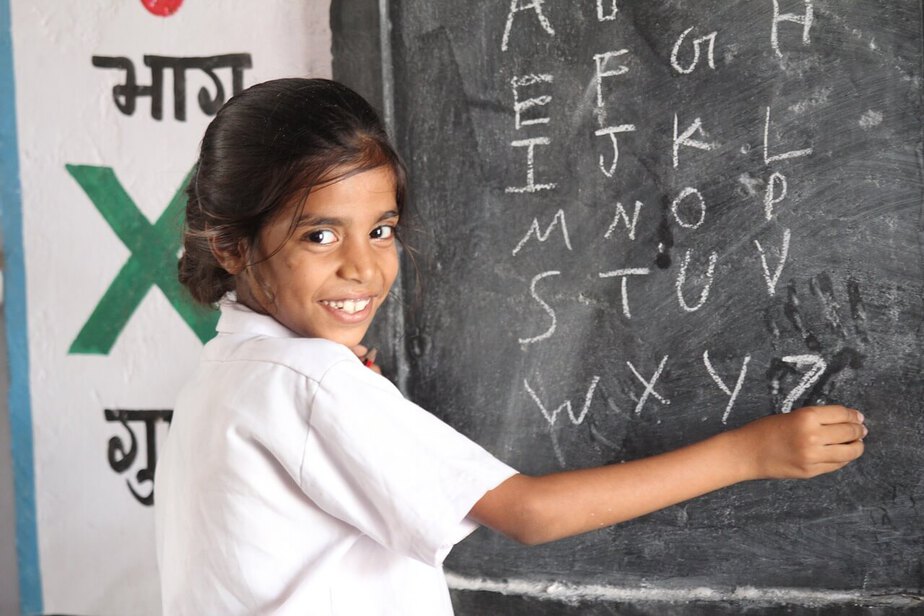Co-authored by Amrita Singh and Tanvi Mehta
At the level of providing pre-primary and primary education, India has been doing well since it features among countries such as Australia, Austria and Canada. However, India is facing an acute learning outcome crisis due to the poor quality of education being imparted to students studying in public schools.
The Dire State of English
Take the case of English as a subject; according to multiple findings, there is a consistent gap in the reading and comprehension skills of students learning English across public schools in India. The Annual Status of Education Report 2016 (ASER 2016) showed 22.8% of the children in the third standard could not even read capital letters and only 32% of children from the same class could read short words. Higher classes faired worse, with only 45.2% of the students from class eight being able to read simple sentences in English, falling from 46.7% in 2014 and 60.2% in 2009. Irrespective of the class students are in, only about 60% of children who can read words can explain their meanings.
These results are depressing, especially given that English has become a kind of ‘global language’. Proficiency in English is considered to be one of the ways in which a person can improve her chances of higher education and job prospects as it enables social empowerment. Professor Rukmini Bhaya Nair, a linguist, says the stock of English has risen considerably in what she calls the “the language of Sensex”. She adds that English is increasingly becoming a source of anxiety and despair for those attempting to cross the boundaries, separating those who “have” English from those who don’t.
In order to make our ever-growing population more interconnected to the world, it’s a must to improve English learning outcomes. Incorporating technology into traditional methods of pedagogy has had a positive impact in this respect. All over the world, technology is increasingly being used to better learning outcomes.
The EnglishHelper Answer
EnglishHelper is a project that provides some answers to the falling standards of state education and English language outcomes; it is an education technology company that works towards making the knowledge of English innovative and affordable in various countries around the world. Their initiative, RightToRead, is spread across thousands of public schools in India in the form of a software called ReadToMe. One of these schools is located in Fatehpur Beri, a tiny village in South Delhi’s posh Chattarpur area.
This school consists of two interconnected buildings, a large playing field, 500 young boys and their teachers, dedicated to imparting quality education. “My dream is to become a big businessman,” says Ravi Shankar, a fifth class student in MCD Boys School, Fatehpur Beri. Articulated in grammatically sound English, Ravi makes clear that he understands English to be the language of success, fame, and fortune.
Boys in classes three to five learn English in a ‘Smart Class’, equipped with a projector and a software that teaches students to speak in English with the correct pronunciation of words. Along with a focus on pronunciation, the software allows students to translate words in Hindi to grasp their meanings and view a picture dictionary that gives a visual aid. Here is an example of how their classes take place:
ReadToMe has been functional in this MCD Boys Primary School for the past five months, the teachers say that there is a considerable amount of improvement. Ms. Asha Ghai, the Principal of this school has been at her post for seven years, ensuring her students get the opportunity to be who they want to be. She understands the importance that English has in her students’ lives; English will allow her students to emerge out of their current socioeconomic status. Here is what Asha Ghai had to say about it:
ReadToMe allows students to gain confidence to speak and converse in English as it helps improve their reading and comprehension skills. The software also makes students self-reliant learners, motivating them to study and know more at their own pace.
Asha Ghai believes that ReadToMe is a great motivational factor for teachers as well because it encourages engagement, interaction and actual learning. Teachers in government schools are usually entrusted with other governmental administrative tasks and this software has made teaching easier for them as it is user-friendly, making classes fun and fruitful at the same time. A tech-enabled class like this one is also able to aspire for roles that may seem like a distant reality for most of these students. These boys want to be scientists, pilots, businessman and doctors, to name a few professions, owing to their exposure to various fields in their interactive and empowering English classes.
A model such as this, helpful for both teachers and students, can work towards eliminating most of the problems associated with India’s public education system. Teachers will be motivated to teach an aspirational class and students will be able to make the most of technology by improving their reading and comprehension skills, leading to an increase in learning outcomes.
There are several other such examples in the subcontinent; Raghav Gujala, a Teach For India fellow, began lending his laptop to students for online mentoring sessions through Skype. He managed to do this in a school located in an East Delhi slum. This created ambitious young students who could directly talk to their mentors online. Similarly, EkStep, a platform to connect students with third parties, allows them to access learning materials at both home and school.
Issues of absenteeism of both teachers and students along with traditional rote-learning methods that are neither interesting nor helpful are being addressed through a wise use of technology. It’s time our public education system takes advantage of the boom in technology, which has made it highly accessible and affordable.






